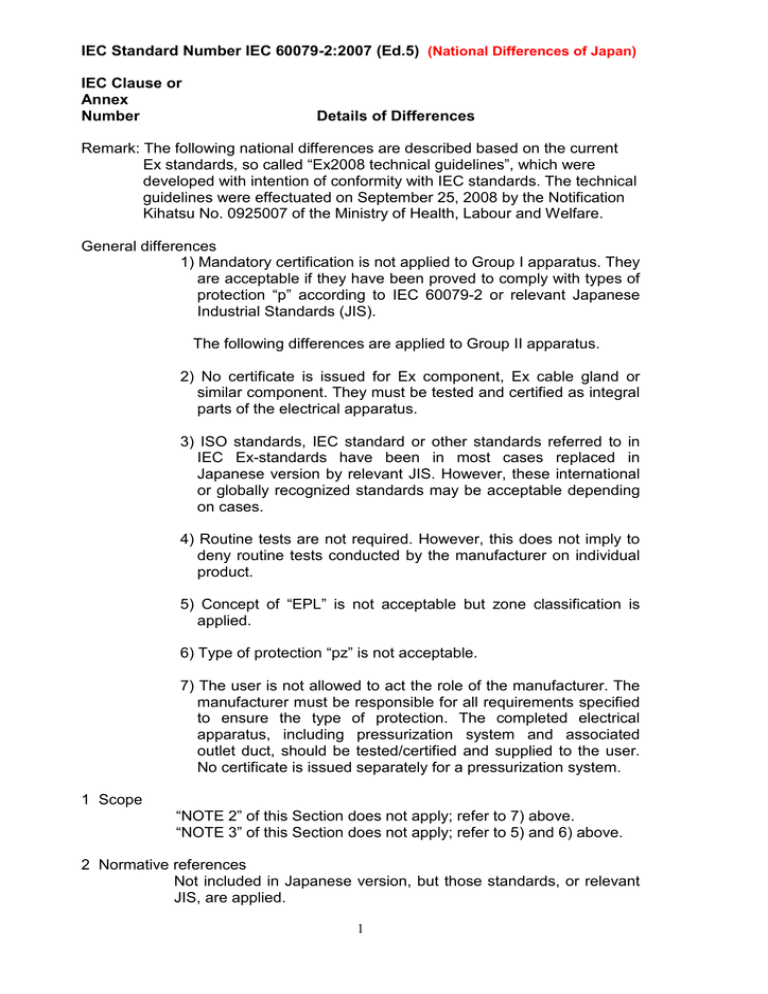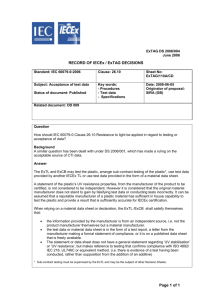INTERNATIONAL ELECTROTECHNICAL COMMISSION
advertisement

IEC Standard Number IEC 60079-2:2007 (Ed.5) (National Differences of Japan) IEC Clause or Annex Number Details of Differences Remark: The following national differences are described based on the current Ex standards, so called “Ex2008 technical guidelines”, which were developed with intention of conformity with IEC standards. The technical guidelines were effectuated on September 25, 2008 by the Notification Kihatsu No. 0925007 of the Ministry of Health, Labour and Welfare. General differences 1) Mandatory certification is not applied to Group I apparatus. They are acceptable if they have been proved to comply with types of protection “p” according to IEC 60079-2 or relevant Japanese Industrial Standards (JIS). The following differences are applied to Group II apparatus. 2) No certificate is issued for Ex component, Ex cable gland or similar component. They must be tested and certified as integral parts of the electrical apparatus. 3) ISO standards, IEC standard or other standards referred to in IEC Ex-standards have been in most cases replaced in Japanese version by relevant JIS. However, these international or globally recognized standards may be acceptable depending on cases. 4) Routine tests are not required. However, this does not imply to deny routine tests conducted by the manufacturer on individual product. 5) Concept of “EPL” is not acceptable but zone classification is applied. 6) Type of protection “pz” is not acceptable. 7) The user is not allowed to act the role of the manufacturer. The manufacturer must be responsible for all requirements specified to ensure the type of protection. The completed electrical apparatus, including pressurization system and associated outlet duct, should be tested/certified and supplied to the user. No certificate is issued separately for a pressurization system. 1 Scope “NOTE 2” of this Section does not apply; refer to 7) above. “NOTE 3” of this Section does not apply; refer to 5) and 6) above. 2 Normative references Not included in Japanese version, but those standards, or relevant JIS, are applied. 1 3 Terms and definitions 3.19 routine test 3.23 type pz These terms do not apply. Requirements or statements on “pz” specified in other Clauses do not apply, if not referred to in the following descriptions. 3.21 type px Replace the definition of this term with the following: “pressurization that reduces the atmosphere within the pressurized enclosure from zone 1 to non-hazardous” 3.22 type py Replace the definition of this term with the following: “pressurization that reduces the atmosphere within the pressurized enclosure from zone 1 to zone 2” 4 Protection type This Clause applies after deleting the term “pz” and replacing the phrase “the equipment protection level ---- gas atmosphere (Mb, Gb or Gc)” with “zone classification of the area in which the equipment is to be used”. Table 1 and Table 2 These Tables apply with the following exceptions: 1) Requirements or statements relating to “pz” do not apply. 2) Replace the phrases in Table 1; “Equipment protection level requirement for” with “Zone classification of”; “Gb or Mb” and “Mb” with “zone 1”; and “Gc” with “zone 2”. 5 Constructional requirements for pressurized enclosures 5.4 Mechanical strength Replace the 2nd sentence of the 2nd paragraph (“If the manufacturer does not --- of this standard.”) with the following: “Such a safety device shall be provided by the manufacturer as an integral part of the electrical apparatus.” 5.8 Spark and particle barriers Replace EPLs in paragraphs 3 and 4 with zone classification. The last paragraph does not apply, and is replaced with the following requirement: “Such barriers shall be provided by the manufacturer as integral parts of the electrical apparatus.” Add the following extra NOTE to this Clause. “NOTE: For continuous flow type pressurization, it is required to locate the outlet of protective gas in non-hazardous area. In this case, no barrier is required.” 2 5.9 Internal batteries This Clause does not apply, because it includes no requirement.. 6 Temperature limits 6.3 For type pz This Clause does not apply. 7 Safety provisions and safety devices (except for static pressurization) 7.2 Integrity of safety devices Requirements and statements on “pz” do not apply. 7.3 Provider of safety devices Replace this Clause with the following: “The safety devices shall be incorporated into the equipment by the manufacturer of the equipment and be tested and certified.” 7.5 Ratings for safety devices 2nd sentence of this Clause is to be read as a requirement, not on the user, but on the manufacturer of the pressurized equipment, in a following manner: “The manufacturer shall use the safety devices within their normal operational limits specified by the manufacturer of the safety device.” 7.7 Purging criteria Item b) of this Clause regarding type pz does not apply. Item c) applies after deleting the phrase “or type pz”. “NOTE” to this Clause does not apply. Deletion of this NOTE in Japanese version implies that “Associated ducts are considered as integral parts of the electrical equipment, and must be tested and certified accordingly. The user is not allowed to provide with any additional duct or to change the purging time preset by the manufacturer and specified in the certification drawings.” 7.9 Safety devices to detect overpressure “NOTE” to item c) does not apply. Deletion of this NOTE in Japanese version implies that “All the sequence, including the purpose of safety devices, must be designed by the manufacturer of the equipment, and be tested. If necessary, the user may advise the manufacturer of the user’s design concept.” See “7.X” on additional requirements below. Item d) of this Clause, regarding type pz protection, does not apply. 7.13 Protection types that may remain energized 1st paragraph applies after deleting the term “q”. Equipment of type “q” protection is certified as Japanese special type of protection. 3 2nd paragraph, regarding type pz protection, does not apply. 7.14 Protection types permitted within type py This Clause applies after deleting the terms “ic”, “mc” and “q”. (Protection types “ic” and “mc” are still not accepted into Japan.) 7.X Additional requirements on the action of safety devices Add the following extra requirements to this Section: “Action of the safety device to be taken when overpressure falls below the minimum value specified by the manufacturer shall be in accordance with the following table:” Protection type px, ICA are included When located in zone 1 When located in zone 2 Immediately disconnect Immediately initiate an the supply automatically alarm, and disconnect the supply manually or automatically with a known delay px or py, Immediately initiate an Immediately initiate an ICA are not included alarm, and disconnect alarm, and disconnect the the supply automatically supply manually or autowith a known delay. matically as quickly as possible 8 Safety provisions and safety devices for static pressurization 8.4 Filling procedure Replace this Clause with the following: “The manufacturer shall fill the pressurized enclosure with inert gas in a non-hazardous area.” 8.5 Safety devices “NOTE” to this Clause does not apply. Deletion of this NOTE in Japanese version implies that “All the sequence, including the purpose of safety devices, must be designed by the manufacturer of the equipment, and be tested.” 9 Supply of protective gas 9.1 Type of gas This Clause applies after deleting the phrase “and any alternative permitted”. This implies that no alternative of the protective gas is accepted. 11 Release conditions 11.1 No release 11.1.2 “NOTE” to item b) does not apply. The manufacturer should be responsible also for the purpose(s) of use of safety device. 12 Design requirements for the containment system 4 12.3 Containment system with a limited release 4th paragraph, regarding the flow limiting device, does not apply. Add the following NOTE in place of this deleted paragraph: “NOTE: In Japan, any part essential for ensuring safety is required to be included into the electrical apparatus to be certified. Thus the flow limiting device should be constructed as one part of electrical equipment, and be tested and certified accordingly.” “NOTE 2” to 5th paragraph does not apply. It is implied that such consideration should be given by the manufacturer upon advice from the user. 13 Protective gas and pressurizing techniques 13.1, Table 4 Replace the term “Air” in the columns for “UEL>80 % for Continuous flow” with “inert only”. 13.3 Pressurization with dilution 13.3.2 Limited release of a gas or vapour Replace the 2nd paragraph, regarding UEL, with the following: “When the flammable substance released from the containment system has a UEL greater than 80 %, the protective gas shall be inert.” 16 Type verification and tests 16.1 Maximum overpressure test 1st paragraph of this Clause applies after deleting the phrase “, where they are an integral part of the enclosure,” The associated ducts and their connecting parts should be considered as integral parts of the pressurized electrical equipment. 16.2 Leakage test Add the following additional Remark to this Clause: “Remark: Leakage test may be considered to suggest possible combination of a pressurized enclosure with a separately certified pressurization system. In Japan, however, only a completed electrical equipment, including a pressurization system, is subjected to certification.” 16.3 Purging test for pressurized enclosures with no internal release --Sub-clause 16.3.3 does not apply, because no such alternative of protective gas is acceptable. 17 Routine tests This section does not apply. 18 Marking 18.3 Supplementary marking There exist some minor differences in supplementary marking. 5 18.5 Static pressurization Replace the warning marking with the following: “Warning – THIS ENCLOSURE IS PROTECTED BY STATIC PRESSURIZATION. THIS ENCLOSURE SHALL BE FILLED ONLY BY THE MANUFACTURER IN A NON-HAZARDOUS AREA” 18.6 Pressurization systems This Clause and associated NOTE do not apply, because no separate certificate is issued for a pressurization system. 18.7 Warnings required in other clauses Warning required in 7.9d), regarding protection pz, does not apply. 18.8 Overpressure limited by user This Clause does not apply, because it is the responsibility of the manufacturer to limit the pressure. Annex D (informative) D.2 Ducting D.2.3 Outlets for protective gas This Clause applies after deleting the phrase “or added by the user”. Such barriers should be provided by the manufacturer when they are necessary. D.2.4 Additional purge time to account for ducting This Clause does not apply. Associated ducts should be considered as parts of the equipment, and the purge duration for the whole equipment should be determined by the manufacturer. Users are not permitted to add such ducts. Annex H (informative) This Annex does not apply. EOF 6


